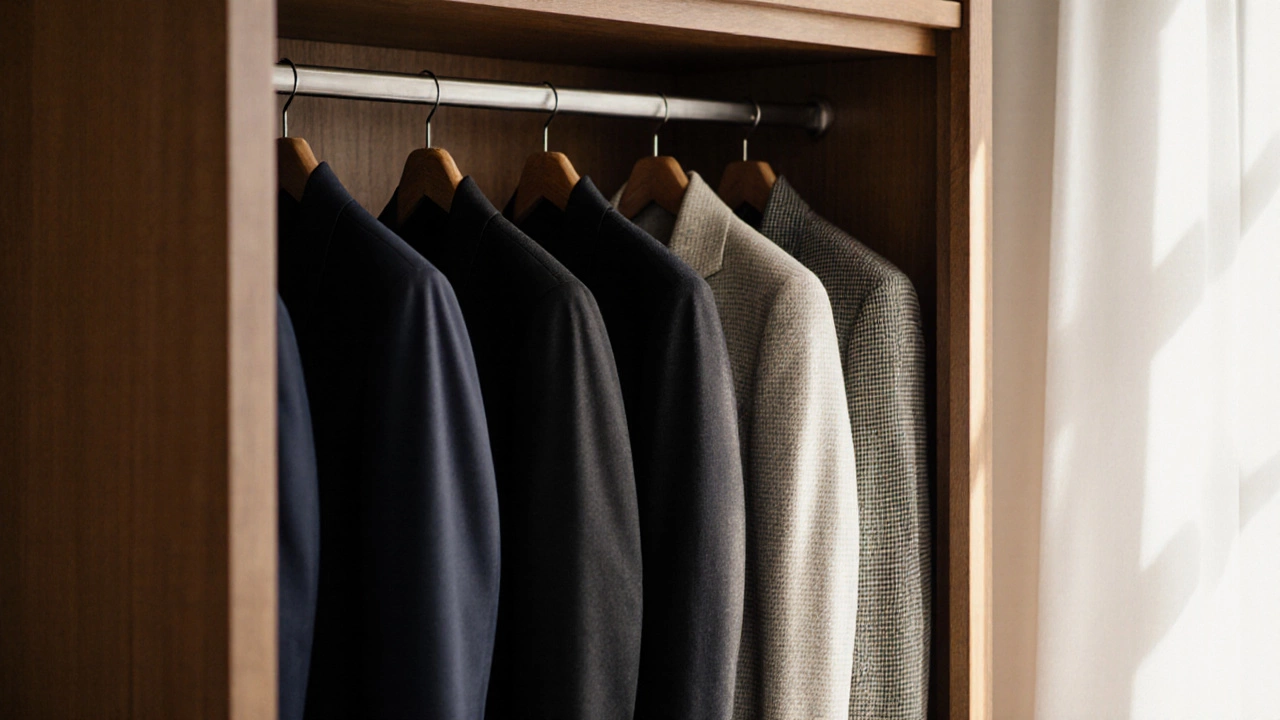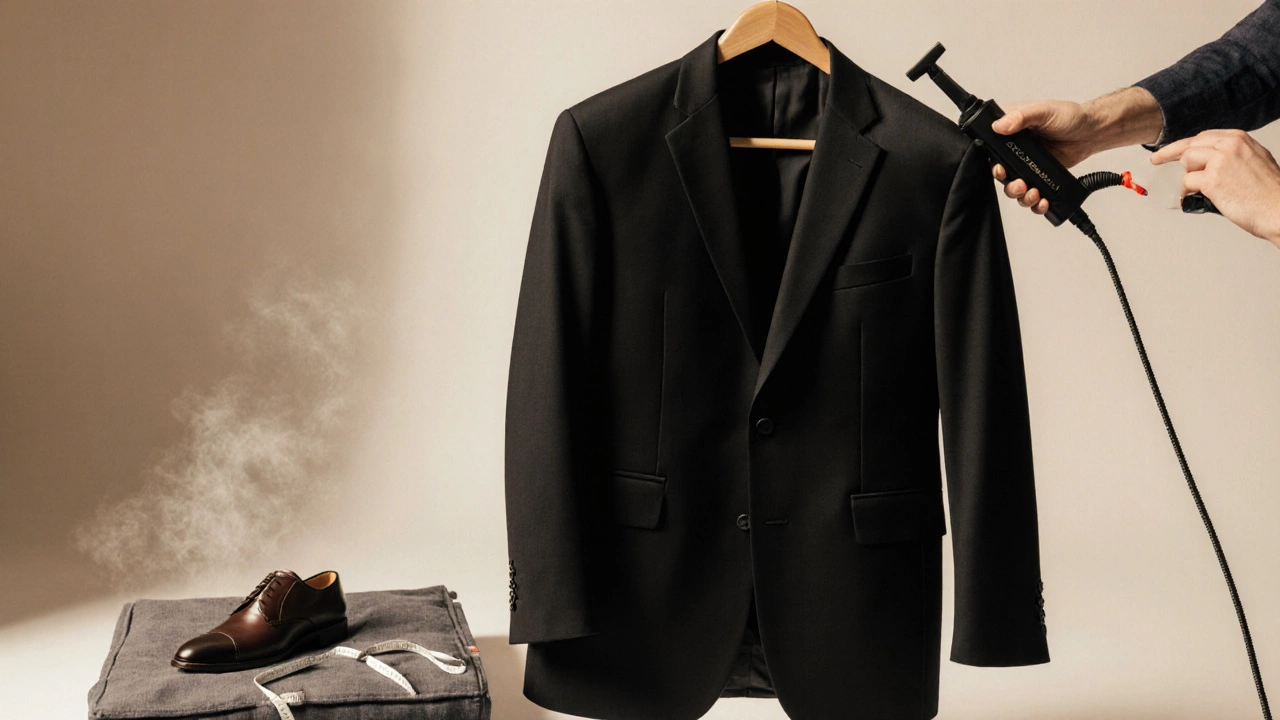How Many Suits Should a Man Own? Essential Wardrobe Guide

- Cleo Fairchild
- 9 October 2025
- 0 Comments
Suit Wardrobe Planner
Your Personalized Suit Recommendation
Core Suit Essentials
Navy Suit
Workhorse for office wear
EssentialCharcoal Suit
Neutral alternative
EssentialBlack Suit
Formal evening events
EssentialWhen talking about a polished look, suit is a coordinated set of jacket and trousers made from the same fabric, typically worn for business or formal occasions. A well‑chosen suit can boost confidence, signal professionalism, and serve as the backbone of a versatile wardrobe.
Key Takeaways
- Three to five core suits cover most work weeks, weddings, and social events.
- Prioritize a navy, charcoal, and a black suit; add a lightweight summer option if needed.
- Choose wool for year‑round use, linen for hot climates, and consider blended fabrics for easy care.
- Invest in quality basics first, then expand with pattern or texture variations.
- Proper storage, cleaning, and occasional tailoring extend a suit’s life for decades.
Why the Right Count Matters
Having too few suits forces you to recycle outfits, which can look lazy and limit your ability to dress appropriately for varied events. Too many, especially low‑quality pieces, clutter closets and waste money. Striking the right balance lets you match the occasion without stress, ensures you always have a clean option on hand, and keeps your overall style consistent.
Core Suit Essentials
Think of the core as a capsule wardrobe for suits. These pieces combine flexibility, durability, and timeless style.
- Navy suit - the workhorse. Works for daily office wear, business lunches, and smart‑casual evenings. Pair with a light blue shirt and a patterned tie for variety.
- Charcoal suit - the neutral alternative to navy. Ideal for presentations, interviews, and more formal business settings. A white shirt and a burgundy tie keep it sharp.
- Black suit - reserved for formal evenings, funerals, and upscale events. A crisp white shirt, black leather dress shoes and a simple black tie create a classic look.
- Lightweight summer suit - consider a linen or a wool‑linen blend in a light gray or beige. Perfect for outdoor weddings and warm‑weather travel.
- Patterned or textured suit - optional once the basics are covered. Tweed, subtle check, or a faint windowpane adds personality without sacrificing professionalism.

Suit Types, Fabrics, and When to Wear Them
| Type | Typical Fabric | Key Colors | Best For | Price Range (GBP) |
|---|---|---|---|---|
| Business Suit | wool (worsted) | Navy, Charcoal | Office, meetings, interviews | 300-800 |
| Formal Suit (Tuxedo) | Fine wool or silk blend | Black, Midnight blue | Black‑tie events, galas | 600-1500 |
| Summer Suit | linen or lightweight wool | Light gray, Beige, Light blue | Outdoor weddings, holiday travel | 250-700 |
| Casual Suit/Blazer Set | Cotton‑twill, Seersucker | Olive, Tan, Patterned | Smart‑casual Fridays, brunch | 200-600 |
Fabric & Seasonal Considerations
A wool suit offers breathability, drape, and natural wrinkle resistance, making it suitable for most climates. Heavier flannel works in winter, while lightweight tropical wool is comfortable in summer. linen feels airy but wrinkles easily; a linen‑wool blend softens the crease issue while keeping the cool feel.
If you live in a temperate zone like Bristol, a 100‑weight worsted wool works year‑round. Add a summer linen option for vacations to hot destinations, and you’ll never feel overdressed or overheated.
Budgeting & Building Over Time
Start with the three core suits. Allocate about 60% of your suit budget to these pieces because quality matters most. Look for reputable British or European brands that offer a good fit‑and‑feel balance at the £300‑£800 level. Once you have the basics, allocate 20% of remaining budget to a seasonal summer suit, and the last 20% to a patterned or textured option that expresses personal style.
Consider buying off‑season sales, outlet stores, or reputable online retailers that provide free returns. A well‑tailored suit purchased at a discount can match a higher‑priced piece in appearance and longevity.

Maintenance & Longevity Tips
Proper care is the hidden cost of any suit collection. Follow these rules:
- Rotate weekly - avoid wearing the same suit two days in a row; this lets fibers recover.
- Spot‑clean minor stains immediately with a damp cloth; never rub harshly.
- Dry‑clean sparingly - once every 4-6 wears for wool, less often for blended fabrics. Over‑dry‑cleaning breaks down fibers.
- Store on a proper hanger with a suit jacket shape; use breathable cloth bags for long‑term storage.
- Press lightly with a low‑heat iron or steamer; avoid direct contact with the fabric.
Schedule a brief tailoring session after the first few wears. A well‑fitted sleeve, jacket length, and trouser break make even a modest suit look custom‑made.
Checklist for a Complete Suit Wardrobe
- ✅ Navy worsted wool suit (2‑piece)
- ✅ Charcoal worsted wool suit (2‑piece)
- ✅ Black formal suit or tuxedo
- ✅ Light gray or beige linen summer suit
- ✅ One patterned or textured suit for personality
- ✅ White and light blue dress shirts
- ✅ Classic black leather dress shoes (Oxford or Derby)
- ✅ A selection of silk ties (solid, subtle pattern)
- ✅ Pocket square (white linen or silk)
- ✅ Leather belt matching shoe color
- ✅ Quality suit bag for travel
Frequently Asked Questions
How many suits does a professional need for a typical work week?
Three to four well‑chosen suits - usually a navy, charcoal, plus an alternate color - let you rotate without repeating outfits.
Can a blazer replace a suit jacket?
A blazer works for smart‑casual settings but lacks the matching trouser fabric, so it’s not a full substitute for formal or business occasions.
Is a black suit appropriate for daytime business meetings?
Generally avoid a black suit for daytime business unless the office culture is very formal; navy or charcoal conveys professionalism with a softer tone.
How often should I have my suits dry‑cleaned?
Aim for dry‑cleaning after every 4‑6 wears, or sooner if the suit gets stained or develops an odor.
Should I buy a suit online or in‑store?
If you’re comfortable with measurements and return policies, online can give better prices. In‑store lets you feel fabric and test fit before buying.


